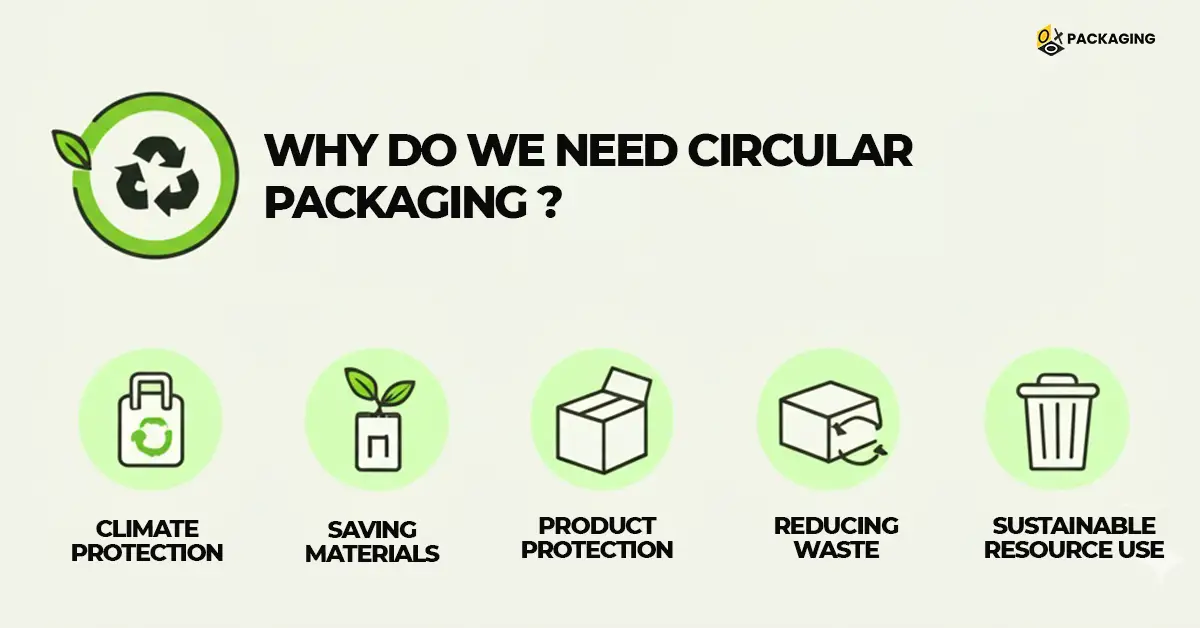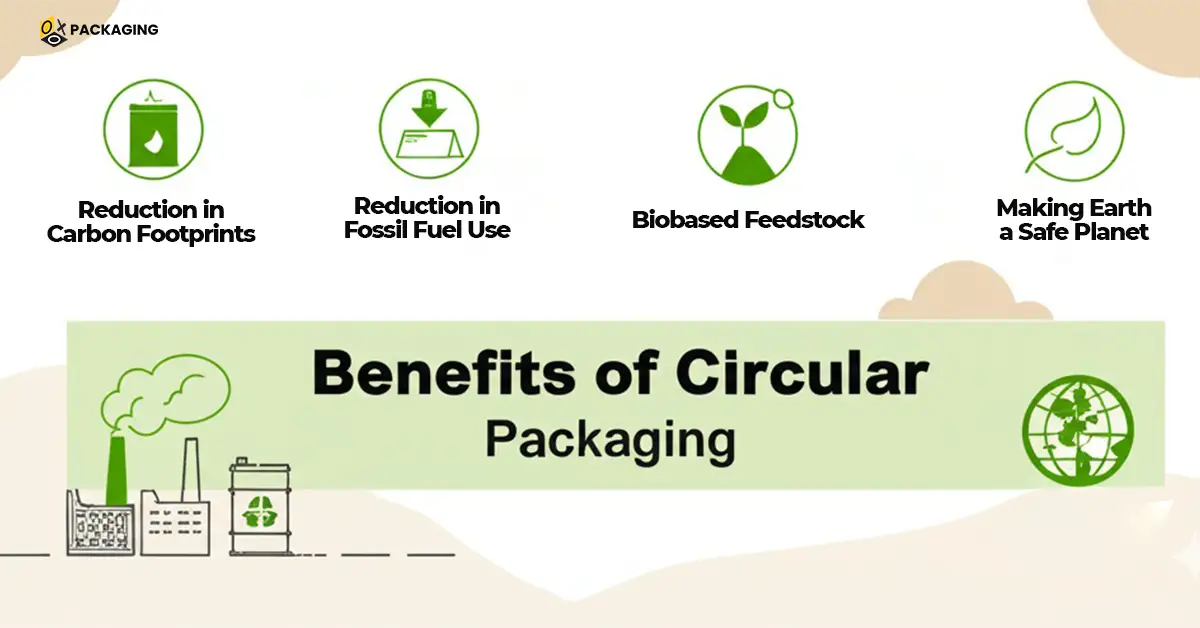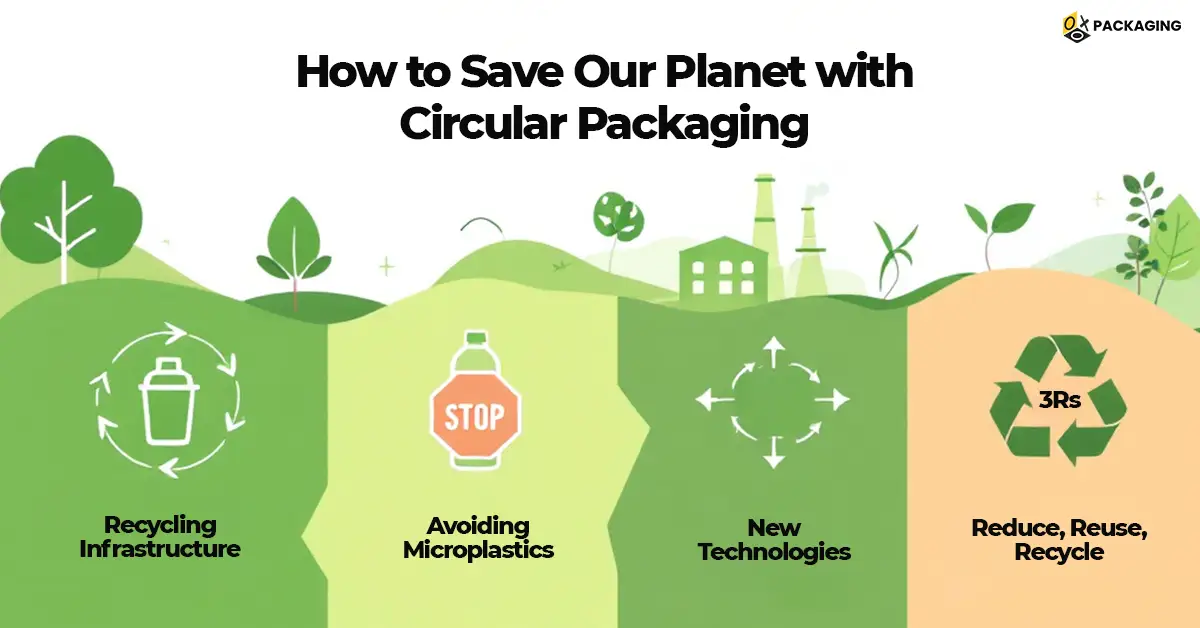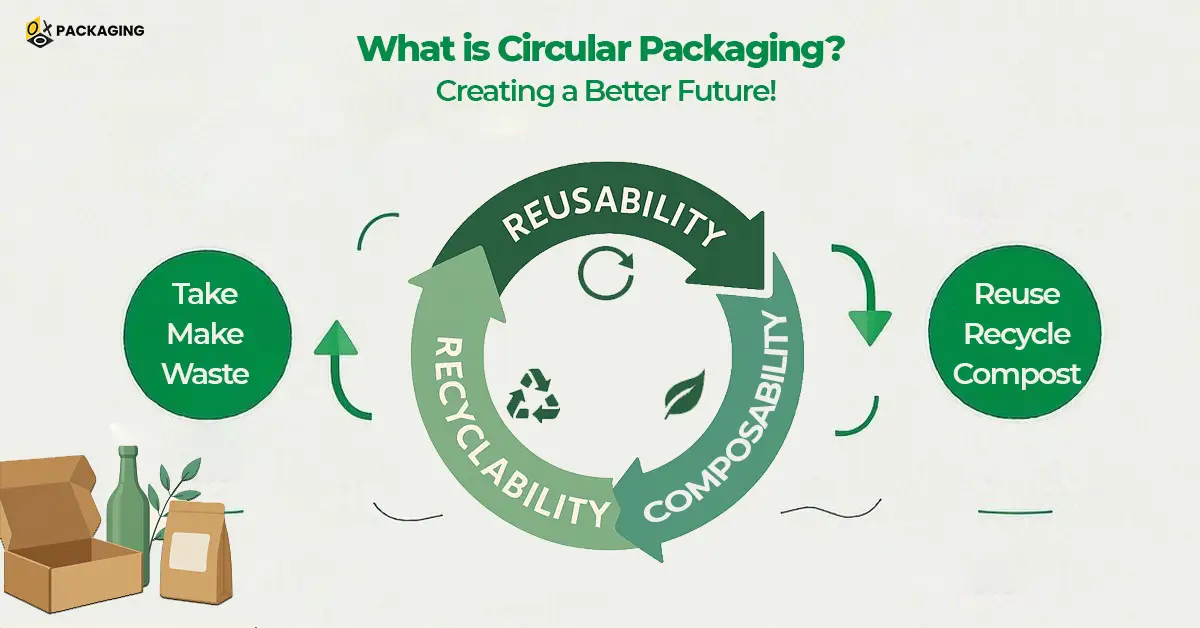Around us, we find an explosion of a variety of products everywhere in markets. Most of them are packaged, wrapped, and come in some sort of packaging material. Packaging business is one of the largest businesses around the globe and becoming even larger with the everyday customer demands for products.
Economies rely on the excessive use of packaging materials with almost no or little renewability, recyclability, and composability. Hundreds of millions of tons of plastic waste ends up in landfills and pollutes waters every year. Now, the shift is rapidly changing to the circular economy and aiming to produce circular packaging more consciously than ever before.
Before we move forward, it’s better to learn what circular packaging is. Circular packaging is about saving the globe from the harmful impacts of conventional packaging materials. Read this blog to learn about circular packaging, its importance, and its future on the globe.
What is Circular Packaging?
The idea of “circular economy” has given rise to circular packaging.
Put simply, this packaging strategy is a lifecycle starting from reusability, moving to recyclability, and then ending with composability. It is a shift from linear economy, i.e., take, make, and waste, to the circular economy, i.e., reusability, recyclability, and composability. It is not just limited to an idea, but it also needs a proper mechanism.
The need of the hour is to support our homeland with our green earth revolutionary measures and campaign. A large number of packaging businesses are aiming to produce circular packaging for their customers' brand packaging solutions.
Why Do We Need Circular Packaging?
Packaging business is a big industry around the globe, and it is consistently growing with the pace of product innovation, creation, and consumption. This is also expected to be bigger, hence, creating a big threat to the earth and becoming a constant climate risk for the future. Consider the following points to reduce impact on the environment:
-
Focus on Climate Protection
Circular packaging enhances environmental protection with several packaging materials and eco-friendly packaging features. It creates less waste and increases reusability and recyclability for repeated usage of the same materials.
-
Save on Packaging Materials
Packaging materials consume a lot of energy, water, and natural resources to produce packaging of products. Avoid excess usage of packaging materials, rethink your packaging designs, and go for the recycling and renewal process to gain maximum utility from the available resources.
-
Improving Product Protection
Product protection is one of the most important and primary functions of product packaging. Critically analyze your product nature, shape, size, and other relevant information to create effective packaging of your brand. This way, you can enhance the protection of your products and fulfill the primary objective of your product packaging, i.e., protection, presentation, and transportation.
-
Prevent Ever-Increasing Harmful Packaging Waste
Before choosing the packaging materials, deeply analyze major features that might reduce the waste of your product packaging. Keep recyclable, reusable, decomposable features of product packaging materials to avoid excessive and increasing waste of your product packaging.
-
Becoming Gentle on Resources
Natural resources used for product packaging are of great importance, and it is important to use them consciously and carefully. Use high-quality packaging materials, but don’t use them lavishly and extravagantly. Design your product packaging with the least material consumption and also be careful about the regeneration features of the specific packaging materials.

Packaging a Big Risk to the Whole Planet?
Most businesses use conventional packaging materials, which is a big reason for the increasing climate change. Usually, it is considered that energy alone is the major reason for climate change. The reality is altogether different to the claim. Read this excerpt to have an idea:
“Climate change discussions often focus on energy consumption, but that’s only half of the equation–or 55% of greenhouse gas emissions”, according to an Ellen MacArthur Foundation report. “The other nearly half of emissions (45%) is due to what we produce.”
The Future is At Stake with Conventional Packaging
The future is at a big risk, especially with the packaging waste and the focus of linear economy, i.e., take, make, and waste. This is the primary concern with conventional packaging that it consistently increases the pollution year by year. We need to prevent pollution and save the climate for our better future.
In simple words, conventional warming has been affecting the globe's environment for years. Now, it is demanding some protective measures to be taken to protect the environment from the harmful impacts of harmful packaging materials.
Benefits of Circular Packaging
Circular packaging is highly desirable to the environment from the worst impact of linear packaging materials, which follows the produce, use, and throw principles. This causes increased landfills, water, and energy resources waste, and increases the pollution around the globe.
The following are some of the major benefits that circular packaging provides with its appropriate usage:
-
Reduction in Carbon Footprints
By using reusable and recyclable packaging materials, you can save a lot of energy resources. Natural resources you use to create effective and efficient packaging might be used time and again, avoiding creating more carbon footprints.
-
Reduction in Feedstock Derived from Fossil Fuel
Material that you use to create something in an industrial process will reduce by focusing on sustainability, recyclability, and reusability features of your product packaging. Avoid using packaging materials mercilessly and keep on focusing on saving energy resources for eco-friendliness.
-
Biobased Feedstock
Carefully choose packaging materials that can reduce carbon footprints, save energy resources, and become a renewable material. This can be a great alternative to the natural resources with carbonized effects in the end.
-
Building Our Earth, A Safe Planet
Use eco-friendly packaging materials, avoid throwing plastic and other harmful waste, and produce post-recycled packaging materials. Create effective packaging design, use sustainable or reusable packaging materials, and avoid landfill packaging materials for green earth friendliness.

Examples of Circular Packaging
Every packaging material that can reduce the harmful impact on earth friendliness is a circular packaging material. Some of the most common examples of circular packaging materials are reusable bottles, mushroom packaging, and fresh food containers.
How to Save Our Planet with Circular Packaging?
The foremost desirable measure to be taken is to promote environmental protection awareness, create a sense of responsibility, and shift to becoming a more sustainable business. Aim to eliminate waste by replacing one-time use plastic packaging with sustainable packaging for multiple-time usage:
-
Developing Recycling Infrastructure and Activities
Give attention to collecting recyclable packaging materials, sort these materials, and produce post-recycled packaging materials. Exert resources on spreading awareness about the green revolution and saving the globe from alarming pollution and carbonized effects.
-
Avoid Micro Plastics and Pollution
Plastic is a very useful packaging material and is used to produce a variety of products packaging. However, this packaging material is not biodegradable, and micro plastics enhance the difficulty in recycling, causing carbonized effects in the environment.
-
Develop New Technology and Production Methods
Have a clear focus on developing new technologies and production methods to enable more sustainable use of resources. Discover innovative and advanced technologies being worked out for the circular packaging requirements to save our green earth.
-
Focus on “Reduce, Reuse, and Recycle”
Encourage the use of renewable packaging materials to reduce the reliance and dependence on natural resources. Follow the concept of “Reduce, Reuse, and Recycle” to decrease the worst impact on climate change. This process will also boost energy saving and enhance the efficient use of available resources.

Choosing Materials for Circular Packaging
From a variety of packaging materials, it is not easy to say firmly which material you should use for product packaging. The nature of products, brand guidance, and relevant regulatory authorities’ guidance are the major determining factors in the selection of packaging materials. However, the following are some stats that provide a snapshot of the impact of packaging materials on our environment.
According to the U.S. Environmental Protection Agency (EPA), in 2018, 14,530 tons of plastic containers and packaging were produced. A major share of 10,090 tons of plastic containers and packaging were landfilled, denoting almost 70% of it was caused to impact the environment badly. At the same time, only 1,980 tons of plastic containers and packaging were recovered.
On the other hand, 41,900 tons of paper and paperboard containers and packaging were produced during 2018. Only 6,440 tons of it was landfilled, and almost 15.4% created an impact on the environment. At the same time, 33,890 tons of paper and paperboard containers and packaging were recycled, and almost 80.9% of it was recovered and renewed for reuse purposes.
Comparing the two stats, we are sure that we must consider different determining factors for the selection of appropriate packaging materials for product packaging. Hence, you should rethink your packaging design and avoid packaging that ends up in landfills. This way, you can reduce environmental impact and embrace circularity for green earth friendliness.
Protecting the Climate with Circular Packaging
Circular packaging is all about creating a positive impact and reducing the harmful impact on the environment. This packaging concept is not a mere ideology. It is an action plan that provides detailed guidance about how to protect the climate. It covers the product packaging materials selection process to the creation of renewable packaging materials production.
Circular packaging is a comprehensive solution designed to systematically reduce the consumption of virgin raw material, which results in reducing manufacturing waste. It also aims to use recyclable content as a priority and pay attention to placing only sustainable packaging on the market.
The circular packaging provides an idea of easy sorting, collection of used packaging materials, and process after use. Producers are more responsible in giving attention to details, and use multi-layer, recyclable materials at priority. Give attention to reducing overall packaging and focusing on the less reliance on the use of virgin materials to more sustainability options.
Conclusion
The circular economy, also known as the “cradle-to-cradle” model, is a great concept that focuses on a sustainable alternative to the “cradle-to-grave” model of packaging. This concept concentrates on material extraction, processing, and use to produce packaging.
Explore more about the strategies mentioned above and implement circular strategies so you can make a positive impact on the climate.
Circular packaging is designed with sustainability in mind, focusing on reusing, recycling, or composting materials to eliminate waste. It keeps packaging materials in use for as long as possible, reducing reliance on virgin resources and minimizing landfill waste.
Unlike traditional “take-make-dispose” packaging, circular packaging follows a closed-loop system where materials are reused, recycled, or returned to nature, supporting a sustainable, waste-free economy.
Common circular packaging materials include:
- Recycled cardboard and paper
- Bioplastics made from renewable sources (e.g., sugarcane, cornstarch)
- Compostable materials like bagasse or PLA
- Reusable materials like glass, metal, or durable plastics
While initial costs may be slightly higher, circular packaging often reduces long-term expenses by improving brand image, reducing waste disposal costs, and meeting regulatory requirements.
Circular packaging is popular in:
- Food & beverage industry
- E-commerce and retail
- Cosmetics and personal care
- Fashion and apparel
- Electronics
Yes. As governments, consumers, and businesses prioritize sustainability, circular packaging is emerging as a key solution for reducing environmental impact and building a greener future.

